牛津译林版八年级英语上册全套教案汇总
- 格式:docx
- 大小:198.88 KB
- 文档页数:197
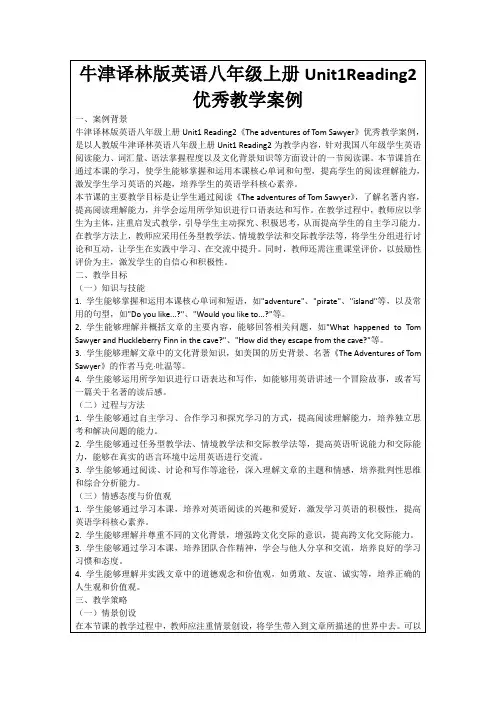
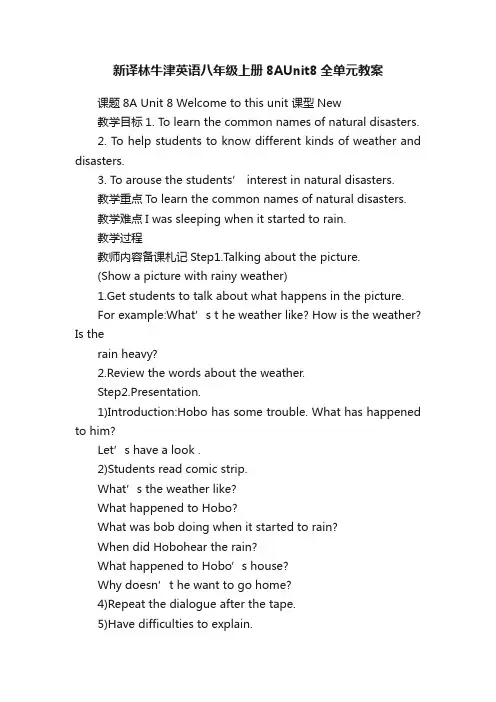
新译林牛津英语八年级上册8AUnit8全单元教案课题8A Unit 8 Welcome to this unit 课型New教学目标1. To learn the common names of natural disasters.2. To help students to know different kinds of weather and disasters.3. To arouse the students’ interest in natural disasters.教学重点To learn the common names of natural disasters.教学难点I was sleeping when it started to rain.教学过程教师内容备课札记Step1.Talking about the picture.(Show a picture with rainy weather)1.Get students to talk about what happens in the picture.For example:What’s t he weather like? How is the weather? Is therain heavy?2.Review the words about the weather.Step2.Presentation.1)Introduction:Hobo has some trouble. What has happened to him?Let’s ha ve a look .2)Students read comic strip.What’s the weather like?What happened to Hobo?What was bob doing when it started to rain?When did Hobohear the rain?What happened to Hobo’s house?Why doesn’t he want to go home?4)Repeat the dialogue after the tape.5)Have difficulties to explain.Be all wet全湿了Mop all the water up用拖把把所有的水拖掉I was sleeping when it started to rain.当开始下雨的时候我正在睡觉。
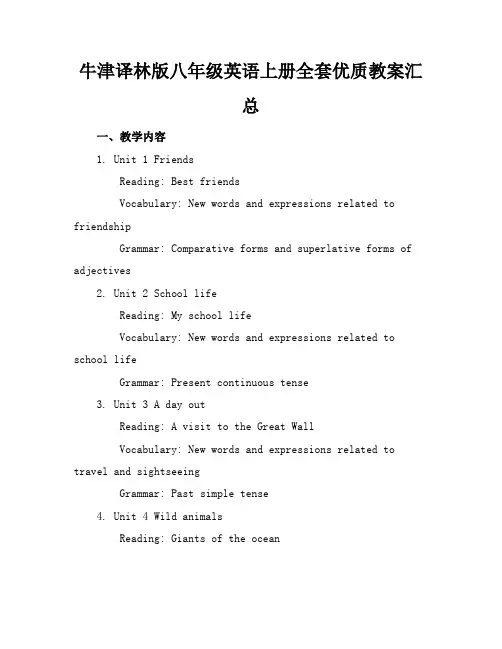
牛津译林版八年级英语上册全套优质教案汇总一、教学内容1. Unit 1 FriendsReading: Best friendsVocabulary: New words and expressions related to friendshipGrammar: Comparative forms and superlative forms of adjectives2. Unit 2 School lifeReading: My school lifeVocabulary: New words and expressions related to school lifeGrammar: Present continuous tense3. Unit 3 A day outReading: A visit to the Great WallVocabulary: New words and expressions related to travel and sightseeingGrammar: Past simple tense4. Unit 4 Wild animalsReading: Giants of the oceanVocabulary: New words and expressions related to wild animalsGrammar: Future simple tense二、教学目标1. 能够理解并运用所学的词汇和语法知识进行日常交流。
2. 能够通过阅读文章,提取关键信息并理解文章大意。
3. 培养学生的英语思维能力,提高他们的听说读写综合运用能力。
三、教学难点与重点1. 教学难点:正确运用比较级和最高级形式描述人物和事物。
掌握现在进行时、一般过去时和一般将来时的用法。
2. 教学重点:培养学生运用目标词汇和语法进行情景对话和写作的能力。
四、教具与学具准备1. 教具:教材投影仪音频播放设备2. 学具:课本练习册笔记本五、教学过程1. 导入:通过展示与单元主题相关的图片或视频,引发学生的兴趣和思考。
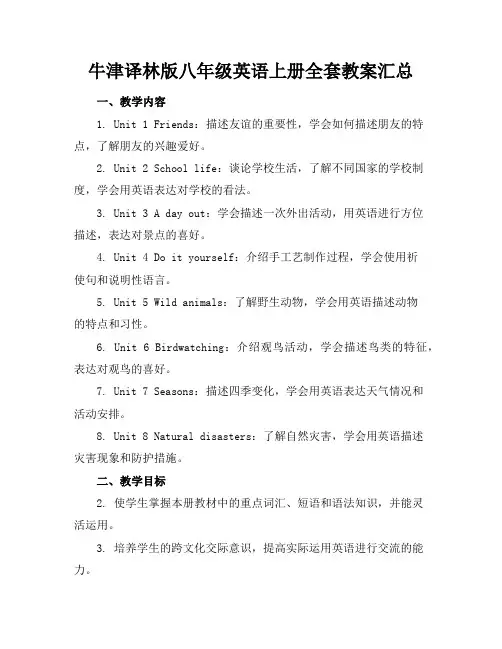
牛津译林版八年级英语上册全套教案汇总一、教学内容1. Unit 1 Friends:描述友谊的重要性,学会如何描述朋友的特点,了解朋友的兴趣爱好。
2. Unit 2 School life:谈论学校生活,了解不同国家的学校制度,学会用英语表达对学校的看法。
3. Unit 3 A day out:学会描述一次外出活动,用英语进行方位描述,表达对景点的喜好。
4. Unit 4 Do it yourself:介绍手工艺制作过程,学会使用祈使句和说明性语言。
5. Unit 5 Wild animals:了解野生动物,学会用英语描述动物的特点和习性。
6. Unit 6 Birdwatching:介绍观鸟活动,学会描述鸟类的特征,表达对观鸟的喜好。
7. Unit 7 Seasons:描述四季变化,学会用英语表达天气情况和活动安排。
8. Unit 8 Natural disasters:了解自然灾害,学会用英语描述灾害现象和防护措施。
二、教学目标2. 使学生掌握本册教材中的重点词汇、短语和语法知识,并能灵活运用。
3. 培养学生的跨文化交际意识,提高实际运用英语进行交流的能力。
三、教学难点与重点1. 教学难点:词汇的拓展运用、语法知识点的理解、口语表达能力的提升。
2. 教学重点:教材各章节的核心词汇、短语、句型及语法结构。
四、教具与学具准备1. 教具:多媒体设备、黑板、教学卡片等。
2. 学具:教材、笔记本、练习本、彩色笔等。
五、教学过程1. 实践情景引入:通过图片、视频等方式,让学生身临其境地感受各个单元的主题,激发学习兴趣。
2. 例题讲解:针对每个单元的重点知识,设计典型例题,引导学生分析和解答。
3. 随堂练习:设置适量练习题,巩固所学知识,提高学生的实际运用能力。
4. 互动环节:组织学生进行小组讨论、角色扮演等活动,培养学生的口语表达和团队协作能力。
六、板书设计1. 每个单元的核心词汇、短语和句型。
2. 语法知识点及其例句。
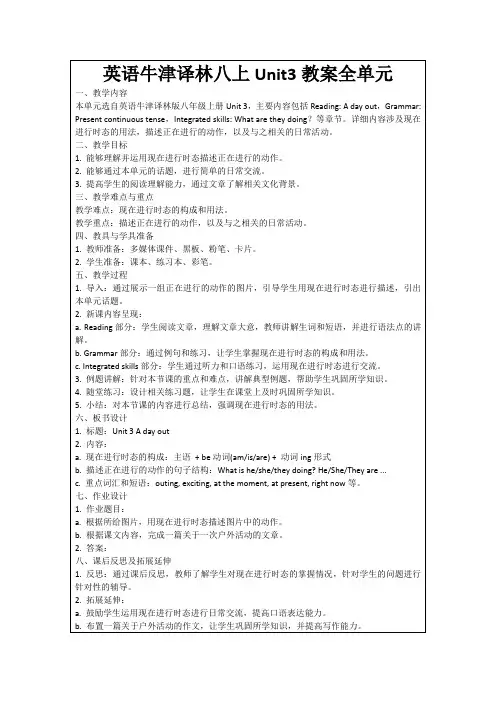
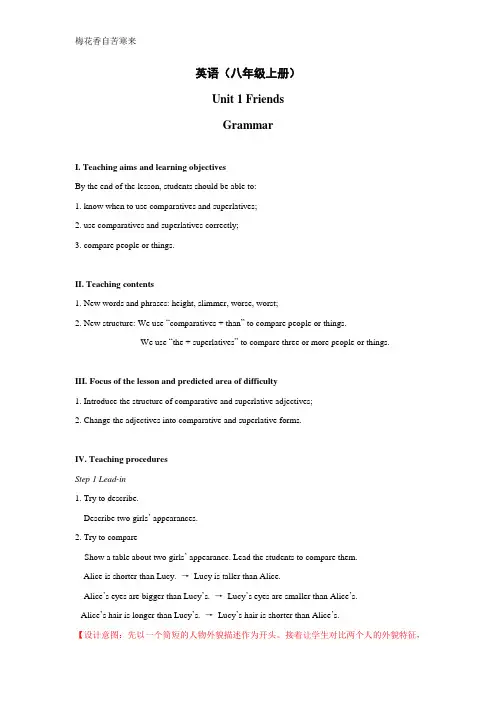
英语(八年级上册)Unit 1 FriendsGrammarI. Teaching aims and learning objectivesBy the end of the lesson, students should be able to:1. know when to use comparatives and superlatives;2. use comparatives and superlatives correctly;3. compare people or things.II. Teaching contents1. New words and phrases: height, slimmer, worse, worst;2. New structure: We use “comparatives + than” to compare people or things.We use “the + superlatives” to compare three or more people or things.III. Focus of the lesson and predicted area of difficulty1. Introduce the structure of comparative and superlative adjectives;2. Change the adjectives into comparative and superlative forms.IV. Teaching proceduresStep 1 Lead-in1. Try to describe.Describe two girls’ appearances.2. Try to compareShow a table about two girls’ appearance. Lead the students to compare them.Alice is shorter than Lucy. →Lucy is taller than Alice.Alice’s eyes are bigger than Lucy’s. →Lucy’s eyes are smaller than Alice’s.Alice’s hair is longer than Lucy’s. →Lucy’s hair is shorter than Alice’s.【设计意图:先以一个简短的人物外貌描述作为开头。
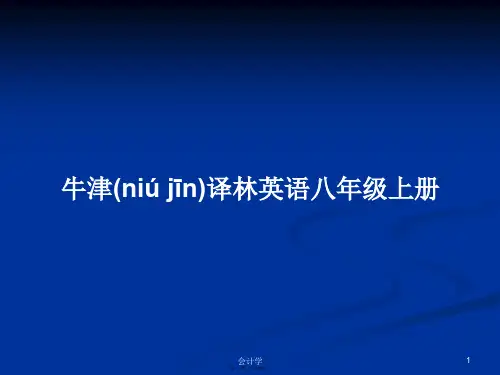
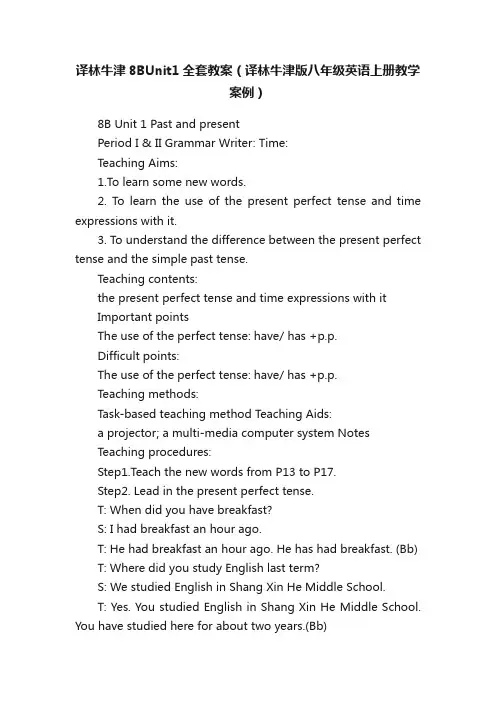
译林牛津8BUnit1全套教案(译林牛津版八年级英语上册教学案例)8B Unit 1 Past and presentPeriod I & II Grammar Writer: Time:Teaching Aims:1.To learn some new words.2. To learn the use of the present perfect tense and time expressions with it.3. To understand the difference between the present perfect tense and the simple past tense.Teaching contents:the present perfect tense and time expressions with itImportant pointsThe use of the perfect tense: have/ has +p.p.Difficult points:The use of the perfect tense: have/ has +p.p.Teaching methods:Task-based teaching method Teaching Aids:a projector; a multi-media computer system NotesTeaching procedures:Step1.Teach the new words from P13 to P17.Step2. Lead in the present perfect tense.T: When did you have breakfast?S: I had breakfast an hour ago.T: He had breakfast an hour ago. He has had breakfast. (Bb) T: Where did you study English last term?S: We studied English in Shang Xin He Middle School.T: Yes. You studied English in Shang Xin He Middle School. You have studied here for about two years.(Bb)→我们用一般过去时谈论过去发生的动作,但当过去发生的动作和现在有联系有影响时,我们用现在完成时态.(Refer to P13)→Structure: have/has +V (过分)Step 3. How we form the past participles of verbs P13 (Add the simple past forms)Add: have---had---had hear---heard---heard buy---bought---boughtgo---went---gone do---did----done eat---ate---eatenforget---forgot---forgotten cut---cut---cut read---read---readStep 4.Explain the use of the present perfect tense.(一) 基本用法:1. 到现在为止这段时间已发生的情况.动作从过去延续到现在.eg. She has been ill for three days. (She’s been…)We have learned 2,000 English words. (We’ve …)2. 某个动作虽是过去发生,但其后果和影响及于现在.eg. Thanks you. I’ve had my supper.(现在用不着吃)Tom has seen the film.(对这部电影有所了解)(二) 时间状语: already, yet(否,疑), since, ever, never, just, before(句尾),for+时间段, recentlyeg. She has already finished her work.I have ever heard about it.Step 5. Change the above sentence patterns to general questions, negative sentences and question the underlined parts.Step 6. Make sentences P14 A1Step 7. Compare the difference between the present perfect tense and the simple past tense.现在完成时的特点是某一动作发生与现在有联系,一般过去时则单纯谈过去发生的某一动作,不涉及对现在的影响.e.g. Simon has lost his watch./ Simon lost his watch.Have you bought a pen? / When did you buy the pen?What did you have for lunch? / Have you had lunch?etc注:句中有表示过去的时间状语如yesterday, last week,…ago etc,不能用现在完成时.Step 8.Chat time P11, A2Step 9. Time expressions with the present perfect tense. P16. BTell students that present perfect tense must have a specific time when it is used. These time expressions include already, ever, for…, just, never, since…, yet, recently. Explain in Chinese ‘already, just, never通常用于have 或has后;而yet 和recently通常放句末。
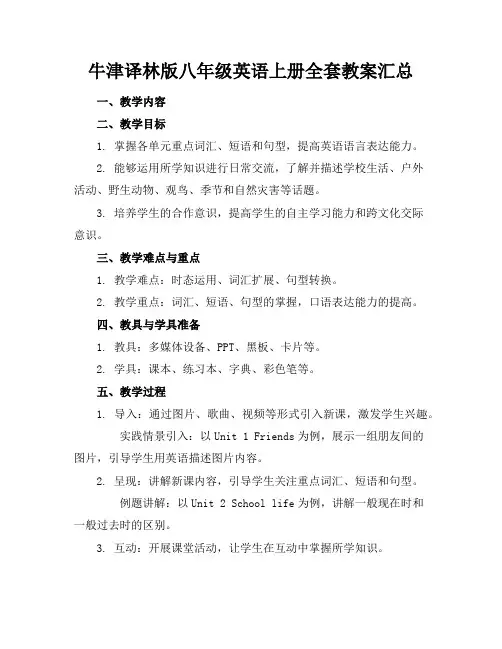
牛津译林版八年级英语上册全套教案汇总一、教学内容二、教学目标1. 掌握各单元重点词汇、短语和句型,提高英语语言表达能力。
2. 能够运用所学知识进行日常交流,了解并描述学校生活、户外活动、野生动物、观鸟、季节和自然灾害等话题。
3. 培养学生的合作意识,提高学生的自主学习能力和跨文化交际意识。
三、教学难点与重点1. 教学难点:时态运用、词汇扩展、句型转换。
2. 教学重点:词汇、短语、句型的掌握,口语表达能力的提高。
四、教具与学具准备1. 教具:多媒体设备、PPT、黑板、卡片等。
2. 学具:课本、练习本、字典、彩色笔等。
五、教学过程1. 导入:通过图片、歌曲、视频等形式引入新课,激发学生兴趣。
实践情景引入:以Unit 1 Friends为例,展示一组朋友间的图片,引导学生用英语描述图片内容。
2. 呈现:讲解新课内容,引导学生关注重点词汇、短语和句型。
例题讲解:以Unit 2 School life为例,讲解一般现在时和一般过去时的区别。
3. 互动:开展课堂活动,让学生在互动中掌握所学知识。
随堂练习:以Unit 3 A day out为例,让学生分组讨论并描述一次户外活动。
4. 巩固:通过练习、游戏等形式,巩固所学知识。
练习:以Unit 4 Do it yourself为例,让学生用所学的动词短语进行句子填空。
六、板书设计1. 单元2. 重点词汇、短语和句型3. 语法点七、作业设计1. 作业题目:根据Unit 5 Wild animals,写一篇关于保护野生动物的短文。
根据Unit 6 Birdwatching,描述你最喜欢的鸟类。
2. 答案:八、课后反思及拓展延伸1. 反思:对本节课的教学效果进行反思,分析优点和不足,为下一节课做好准备。
2. 拓展延伸:鼓励学生课后观看英语动画片、纪录片,提高英语听说能力。
组织英语角活动,让学生在真实语境中练习英语口语。
引导学生关注国内外时事,提高跨文化交际意识。
重点和难点解析1. 教学内容的详细划分和重点突出。
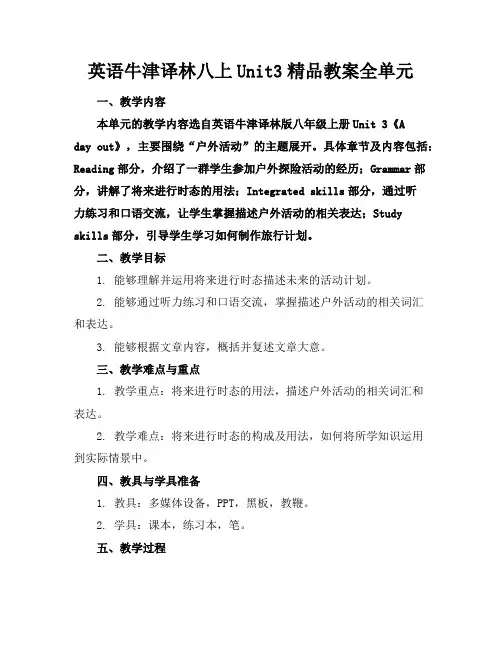
英语牛津译林八上Unit3精品教案全单元一、教学内容本单元的教学内容选自英语牛津译林版八年级上册Unit 3《Aday out》,主要围绕“户外活动”的主题展开。
具体章节及内容包括:Reading部分,介绍了一群学生参加户外探险活动的经历;Grammar部分,讲解了将来进行时态的用法;Integrated skills部分,通过听力练习和口语交流,让学生掌握描述户外活动的相关表达;Studyskills部分,引导学生学习如何制作旅行计划。
二、教学目标1. 能够理解并运用将来进行时态描述未来的活动计划。
2. 能够通过听力练习和口语交流,掌握描述户外活动的相关词汇和表达。
3. 能够根据文章内容,概括并复述文章大意。
三、教学难点与重点1. 教学重点:将来进行时态的用法,描述户外活动的相关词汇和表达。
2. 教学难点:将来进行时态的构成及用法,如何将所学知识运用到实际情景中。
四、教具与学具准备1. 教具:多媒体设备,PPT,黑板,教鞭。
2. 学具:课本,练习本,笔。
五、教学过程1. 导入:通过展示一组户外活动的图片,引导学生用英语描述图片内容,激发学生的学习兴趣。
2. 新课内容呈现:a. Reading部分:让学生快速阅读文章,然后回答问题,引导学生关注文章细节。
b. Grammar部分:通过例句讲解,让学生理解将来进行时态的构成及用法。
c. Integrated skills部分:播放听力材料,让学生完成相关练习,并进行口语交流。
d. Study skills部分:引导学生学习如何制作旅行计划,并进行小组讨论。
3. 例题讲解:针对Grammar和Integrated skills部分的重点内容,设计相关例题,进行讲解。
4. 随堂练习:针对新课内容,设计练习题,让学生进行巩固练习。
六、板书设计1. Reading部分:文章大意,关键信息。
2. Grammar部分:将来进行时态的构成及用法。
3. Integrated skills部分:描述户外活动的相关表达。
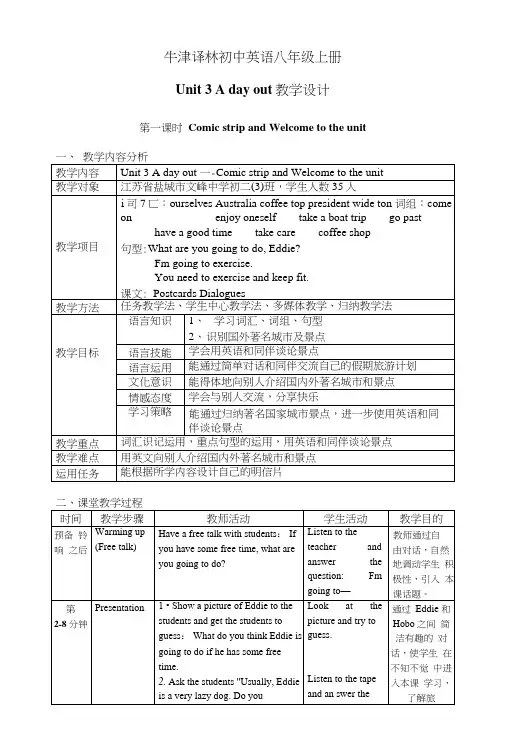
牛津译林初中英语八年级上册Unit 3 A day out教学设计第一课时Comic strip and Welcome to the unit 一、教学内容分析二、课堂教学过程第二课时Reading 1教学内容分析二、课堂教学过程()7. A. Tuesday B. Wednesday C. Thursday D. Friday( )8- A. eleventh B. twelfth C> ninth D. tenth( )9. A. Tuesday B. Saturday C. Sunday D. Friday( )10. A. well B・ great C. beautifully D. happily 答案:BADCA DBACB第三课时Reading 2一、教学内容分析二、课堂教学过程时间教学步骤教师活动第1-5分钟Revision学生活动Finish thetable andcompletethepassage.1. Do you remember Lindaus trip to theWorld Park? Can you complete the tableabout it?2・ Ask the students to complete a shortpassage.It was fine and warm yesterday・ MrWu invited Linda to _______ their schooltrip to the World Park. The waslong and a little . Thev arrived at the Thev quickly the bus and the models of places of interest were there them! Thev were very excited and couldn't . Thev learnt a lot about different . 巩固、运用已学的阅读理解策略与技巧,从而提高学生的阅读理解能力。
牛津8A Unit2全部配套教案(译林牛津版八年级英语上册教案教学设计)Objectives:- To introduce vocabulary used in British English and American English- To distinguish between British and American usage- To sort out vocabularyVocabularyBritish English American English1. American football2. autumn3. break4. corridor5. dustbin6. lift7. film8. football9. ground floor10. Maths11. rubber12. secondary school 1. football2. fall3. recess4. hall5. garbage can6. elevator7. movie8. soccer9. first floor10. Math11. eraser12. high schoolPre-task activities 1. Have my students read the words after the teacher. Pay attention to the pronunciation and the spelling of words.During-task activities 2. Check the answers in pairs, then in class.British English American English13. American football14. autumn15. break16. corridor17. dustbin18. lift19. film20. football21. ground floor22. Maths23. rubber24. secondary school 13. football14. fall15. recess16. hall17. garbage can18. elevator19. movie20. soccer21. first floor22. Math23. eraser24. high school3. Practice.1) Say the words after the teacher.2) Practice in pairs.3) Make sure my students are able to use the words.4. Have my students do Part B, on Page 19.Check the answers in class.Practice reading the words.Post-task activitiesUnit 2 School lives (Pp. 20 – 22) ReadingObjectives:- To guess general meanings from pictures and keywords. - To understand feelings and opinions.- To identify specific information about school life. Language focus:1. life in a British school (l. 1)life in an American school (l. 16)2. in Year 8 (l. 3)in 9th grade (l. 18)3. a mixed school (l. 4)4. have lessons together (l. 4-5)5. my favourite subject (l. 5)6. how to do things for myself (l. 6-7)how to cook healthy and tasty meals7. have a reading week (l. 9)8. bring in books and magazines from home (l. 11)9. the end of each class (l. 12 - 13)10. talk to our friends about our books (l. 13)11. our friends’ books (l. 15)12. as well (l. 15)13. in Denver (l. 19)14. have driving lessons (l. 20)have a driving lesson15. every day 16. twice a week (l. 23)17. play softball (l. 23)18. spend a lot of time practicing (l. 24)19. go to a ‘buddy club’ (l. 24-25)20. at the buddy club (l. 25)21. older students (l. 25)22. enjoy this a lot (l. 26)23. a senior in 12th grade (l. 27)24. help me learn (l. 27)25. help me with my homework (l. 28-29)26. listen to my problems (l. 28)27. my hero (l. 28)my heroes28. during lunchtime (l. 29)29. meet my friends (l. 29)30. have a great time (l. 29)31. talk to each other (l. 29-30)32. go to shopping malls (l. 30)33. after class (l. 30)Pre-task activities Brainstorming and Free discussion: What do you like in our school?What makes you unhappy?Which is your favourite subject?What subjects do you study at school?What subjects do you want to study at school?Do you want to study in Britain?Do you want to study in America?Why?During-task activities 1. Fast readingRead the articles on Page 20 as quickly as possible. Fill in the blanks below.Name John NancySchool Woodland School Rocky Mountain High SchoolGrade 8 9In class(Subject) Home Economics Driving lessonsAfter class(activities) A readin g week Play softball; go to a ‘buddy club’2. Detailed study of the articles and word guessingLife in a British School1) About a mixed schoolWhat kind of school is Woodland School? (A mixed school.) Who studies in a mixed school? (Boys and girls. They have lessons together.)There are some schools for girls only. Is our school a mixed school or not? (Yes, it is.)2) About Home EconomicsHome Economics is John’s favourite subject. It is one of the subjects in Woodland School.What can students learn in this subject? (How to cook healthy and tasty meals. ‘Tasty meals’ means meals with a pleasant taste.)Exercise 1Hi everybodyMy name is John. I am in Year 8 at Woodland School near London. It is a mixed school. Boys and girls have lessons together.My favourite subject is Home Economics. I like learning how to cook and sew. I did not know how to do things for myself before I came to this school. Now, I know how to cook healthy and tasty meals.3) About the reading weekSuppose you are John. Answer my questions:- How often do the students in Woodland School have the reading week? (Every year. = once a year.)- Can the students read all the books from the school library? (Yes, they can.)- What can you bring in (the library) from home? (Books and magazines.)- What must you do if you want to read books and magazines from home? (Tell our English teacher what we are reading. ‘have to’ = ‘must’)- Who can you talk to about your books near the end of each class? (Our friends.)- Do you like the reading week? Do you think it is too long? Why not? (We want to read all our friends’ books as well. ‘as well’ = ‘too’)Exercise 2Our school has a reading week every year. My classmates and I (我和我的同学们)love it. We can read any books from the school library. We can even bring in (把……带来)books and magazines from home but we have to (必须) tell our English teacher what we are reading. Near the end of (在……的结尾)each class we can talk to our friends about (对……谈论关于……)our books. The reading week is always too short because we want to read all our friends’ books as well (也).Life in an American School1) About driving age in the USA- Students at 17 years old are in 12th grade in the USA.- Students in 11th grade can have driving lessons.Exercise 3Hi guys,I’m Nancy and I’m 14 years old. I’m in 9th grade (在九年级)at Rocky Mountain High School in Denver. My brother’s name is Jim. He is 17 years old. He had driving lessons (驾驶课)in school last year. Now, he drives me to school (开车送我上学)every day. This is great b ecause it’s faster than (比……快)taking the bus.2) About softball- When do you play softball?- How often do you play softball?3) About the ‘buddy club’3.1) Home Economics2) Tasty3) As well4) Softball5) Buddy4. Detailed study of the text5.Post-task activitiesUnit 2 Making comparisons (Pp. 26 – 27) GrammarObjectives:- To compare two things using ‘like’ and ‘alike’- To make comparisons using ‘the same as’ and ‘different from’Language focus:Structures:- Amy’s sweater is like Millie’s sweater.- (Amy’s shoes are like Millie’s shoes.)- Amy’s sweater and Millie’s sweater are alike.- My uniform is the same as Simon’s uniform.- My uniform is different from Simon’s uniform.Vocabulary:Words about Stationery: ruler, paper, pencil, rubber, notebooktimetablePre-task activities 1. What are they wearing?Look at the picture on page 26.- How many students are there in the picture? (Four.)- What are they wearing?(Daniel is wearing a yellow jacket and a scarf.)(Simon is wearing sports clothes.)(Amy is wearing a red sweater.)(Millie is wearing a red sweater, too.)- Amy’s sweater is like Millie’s sweater.- Amy’s sweater and Millie’s sweater are alike.Have my students read the sample sentences and remember them.During-task activities 2. Things that are similar1) Have my students do Part C1.2) Check the answers in pairs.3) Ask my students to read the sentences aloud and check the answers in class.3. What stationery do you have?Have my students list the stationeries they have now. T each the word s ‘notebook’ and ‘paper clips’.Post-task activities 4. Things in your school bags.- My pen is like yours.- Our notebooks are alike.Pre-task activities 5. What are they wearing?Look at the pictures on page 27. What are the boys wearing? (They’re wearin g school uniforms.)- Daniel’s uniform is the same as Simon’s (uniform).- Daniel’s uniform is different from John’s (uniform).It’s better to use what my students are wearing as the presentation.During-task activities 6. Same or different?1) Have my students do Part D1.2) Check the answers in pairs.3) Ask my students to read the sentences aloud and check the answers in class.4) Then, go through Part D2 the same way.Post-task activities Exercises on the Workbook:How are their daily lives? (Pp. 26 – 27)Unit 6 An accident report (Pp. 100– 101) Integrated skillsLanguage focus:Vocabulary:1) New words:2) Numbers in EnglishStructure: more … than; fewer … than; less … than1) There are more students in Rocky Mountain High School than in Woodland School.2) There are fewer students in Rocky Mountain High School than in Beijing Sunshine Secondary School.3) Rocky Mountain High School has more students than Woodland School.4) Rocky Mountain High School has fewer students than Woodland School.5) Chinese students have more weeks off in the summertime than British Students.6) British students spend less time doing their homework than Chinese students.Pre-task activities 1. John’s school, Nancy’s school and your school1) Which school is John in? (Woodland School, Britain.)2) Which school is Nancy in? (Rocky Mountain High School, the USA.)3) Which school are you in? (Nanjing No. 13 Middle School.)4) Which class are you in?5) How many students are there in your class?6) How many boys are there? How many girls are there?(There are more / fewer boys than girls in my class.)7) How many students are there in your grade?8) How many students are there in your school? How many teachers?9) How many students / teachers are there in Woodland School / Rocky Mountain High School?During-task activities 2. Numbers of students, teachers and classrooms; length of summer holidayA. Read the chart on Page 28.1) How many students are there in Woodland School? (550.)2) How many classrooms are there in Beijing Sunshine Secondary School? (45.)3) How many classrooms are there in Rocky Mountain High School? (35.)4) How long do the Beijing Sunshine Secondary Schoolstudents have their summer holiday? (7 weeks.)‘long’ & ‘length’B. Listen to the conversation between Sandy and Daniel. Complete the table of Part A1, on Page 28.- There are 550 students in Woodland School.- The students in Beijing Sunshine Secondary School have 7 weeks off in the summertime.D. Structures1) There are more students in Rocky Mountain High School than in Woodland School.2) There are fewer students in Rocky Mountain High School than in Beijing Sunshine Secondary School.3) Rocky Mountain High School has more students than Woodland School.4) Rocky Mountain High School has fewer students than Woodland School.5) Chinese students have more weeks off in the summertime than British Students.6) British students spend less time doing their homework than Chinese students.E. Comparing Schools, Part A2, Page 28.F. Comparing Schools, Part A3, Page 29.Unit 2 Talking about different schools (P. 29) Speak upObjectives:- To develop fluency in asking and answering questions about school.- To develop interactive skills by responding appropriately.- To transfer a model conversation to a personal situation.Language focus:Vocabulary: kilometreStructures:1) How far do you live from your school?How far is it from your home to school?2) Do you walk to school?Do you go to school on foot?3) I usually take the school bus.I usually go to school by bus.4) What if it rains or snows?What are you going to do / do you do if it rains or snows?5) It doesn’t snow / rain, etc.6) I don’t mind the rain.Pre-task activities Mini-task I: How do you go to school?- How do you go to school every day?- How long does it take?1) T – S2) S – SDuring-task activities Mini-task II: How do they go to school?1. Listening task- Daniel goes to school by bus.- John walks to school2. Reading aloudRead after the tape twice.3. Language studies7) How far do you live from your school?How far is it from your home to school?8) Do you walk to school?Do you go to school on foot?9) I usually take the school bus.I usually go to school by bus.10) What if it rains or snows?What are you going to do / do you do if it rains or snows?11) It doesn’t snow / rain, etc.12) I don’t mind the rain.4. Role-playPost-task activities Additional exercises on language points:I. Fill in the blanksNancy: How far do you live from your school?John: About two kilometres.Nancy: Do you go to school on foot?John: Yes, I walk to school every day. I like walking. And you?Nancy: I usually ride my bicycle to school. (I usually go to school by bike.)It’s fun (funny).John: What if your bicycle doesn’t work?Nancy: I don’t mind. I can take a bus then.(I can go to school by bus then.)II. Translation1) The air pollution in Sunshine Town is less than that (the air pollution) in other areas of Beijing.There is less air pollution in Sunshine Town than in other areas of Beijing.2) British students spend less time (in) doing their homework than Chinese students (do).3) How far is your home from your school? About 10 kilometres.How far do you live from your school?About 10 kilometres.4) I don’t mind if it will rain tomorrow.Unit 2 My ideal school (Pp. 31 – 32) Main taskObjectives:- To complete a questionnaire with personal information.- To select specific information for an ideal school week including the choice of favourite activities.- To generate and organize ideas about an ideal school and write an article about it for website audience.Language focus:Vocabulary: finish, tick, baseball, table tennis, tennis, chess, drama, support, ideal, pop, tennis courtPhrases:1. get up late2. my ideal school3. start at 9 a.m.4. finish at 3 p.m.5. have lots of time for after-school activities6. have an hour for lunch7. a big dining hall8. eat lunch and chat9. listen to pop music10. in the hall11. eat fruite and vegetables12. every day13. have Maths14. love computers15. have Computer Studies16. before lunch 17. wear school uniforms18. wear ties19. be quite small20. in each class21. have a park22. on one side23. the other24. have a big library with lots of useful books25. have a tennis court and a swimming pool26. lots of clubs27. after-school activities28. have half an hour of homework29. at weekends30. go on a school trip to a museum or a theatrePre-task activities Mini-task I: Your ideal school1) When does your school start / finish? When do you get up?2) How much time do you have for lunch? What do you do after lunch?3) What subjects do you have every day? How many students are there in your class? Do you have to wear uniforms and ties?4) Where is your school? What is around your school? What is your favourite place in your school?5) What do you do after class? Every month? Every year?During-task activities Mini-task II: Daniel’s ideal school1) Introduction: starting and finishing time of school2) Lunchtime: length, location, food3) Subjects, school uniform and size of classes4) Environment and facilities5) Clubs and activitiesPost-task activities Where do you want to go on with your studies after your leave No. 13 Middle School in 2006?Unit 2 Showing surprise (P. 30) PronunciationObjectivesTo recognize and use intonation patternsTo recognize and use falling voice to indicate the end of astatementTo recognize and use rising voice to show surpriseLanguage focusVocabulary1. monkey n.- Joe wants to get a pet monkey.2. news n.- Did you hear the news?Tense1. Laura hurt her leg on Monday.2. She won’t be able to play basketball for three months.3. Look out the window. It’s snowing!4. Mr. Wu is going to be on TV tonight.5. Joe wants to get a pet monkey.6. You just ate four hamburgers.7. We’ll have cakes for dinner tonight.8. Did you hear the news? Liu Mei is going to move to Canada.I don’t believe it.During-task activities Mini-task I: Poor LauraA. Amy and Sandy are talking about their classmate Laura. Try to fill in the blanks below.Amy: Laura hurt her leg on Monday.Sandy: Oh, really!Amy: She has to stay in hospital for a month.Sandy: A month!Amy: Yes. She won’t be (be) able to play basketball for three months.Sandy: Three months!B. Amy and Sandy are talking about their classmate Laura. Listen to their conversation and fill in the blanks.C. Listen to the conversation. Pay attention to the intonation patterns. Read after the tape.D. Role-playMini-task II: IntonationA. Read the sentences and fill in the blanks.1) Look out the window. It is snowing (snow)!2) Mr. Wu is going to be (be) on TV tonight.3) Joe wants (want) to get (get) a pet monkey.4) I’m hungry.Hungry? You just ate (eat) four hamburgers.5) We will have (have) cakes for dinner tonight.6) Did you hear (hear) the news? Liu Mei is going to move (move) to Canada.B. Read the sentences and put an arrow at the end of each sentence.C. Listen to the tape and check the answers.D. Read after the tape.。
牛津译林版八年级英语上册全套教案汇总共计198页牛津译林版八年级英语上册Module 1 Teenage life教案汇总(Unit1—Unit4)Unit 1 FriendsComic strip and Welcome to the unitI. Teaching aims and learning objectivesBy the end of the lesson, students should be able to:1. identify the new words and phrases;2. describe people’s qualities with simple and proper words;3. know more about friendship and try to develop some good qualities.II. Teaching contents1. New words and phrases: thirsty, honest, care about, keep a secret, make sb happy, be ready to do sth, have problems, believe what he/she says, tell lies/funny jokes.2. New structures: Can I have something to drink?Can I have some more food?What makes good friends?You can trust them because they never tell lies.III. Focus of the lesson and predicted area of difficultyDescribe people’s qualities with simple and proper words.IV. Teaching proceduresA Comic stripStep 1 Lead-in1. The topic of the unit ― friendsT: Hello, boys and girls, do you have a friend? Yes, of course, you do. As we know, every one of us should have at least one or two friends. Time seems to go faster when good friends are together.2. Free talkAsk some open questions:Who is your good friend?Could tell us something about your good friend?Why do you choose him/her as your good friend?【设计意图】从谈论身边的朋友引入课题,拉近与学生的心理距离,学生有了表达的欲望,也能用自己的语言初步描述朋友的性格。
译林英语八年级上册教案(精选5篇)译林英语八年级上册教案(精选篇1)一、说教材1、教材内容及地位本节课的主要内容是新目标英语八年级上册第2单元第一课时,教材是以what’s the matter ?为中心话题,描述身体不适和提出建议展开,学习和运用“what’s the matter ?”和“what should…do?”让学生学会描述身体的不适和提出建议,本课教材内容与学生的实际生活密切相关,易于引出学生运用简单的英语进行交际和交流,在学习活动中,学生通过交换对身体不适的描述及建议,促进学生之间和师生之间的情感交流,增进情谊。
第一课时主要学习的内容是学习有关身体部位的单词,学习“what’s the matter ?”和“what should …do?”句型。
2、说教学目标(1)知识目标:学习掌握有关身体的词汇以及有关疾病的词汇,并学会描述身体的不适和提出建议。
(2)能力目标:听懂本课学习活动中的问题及回答,能在本课的任务型活动中进行简单的交流,能正确朗读本的对和句型,能写出本课的单词和句型。
(3)情感目标:通过描述自己的身体的不适提出建议,表达自己的看法,使学生在人际交往中学会关心别人,增进情谊。
(4)文化意识目标:用恰当的方式表达自己的看法,增进人际交往中学会关心别人的能力,了解英美国家询问和表达身体不适的习惯,培养世界意识。
3、说教学重难点重点:本节课主要学习身体部位的单词和一些疾病的词汇,以及身体不适的表达及建议。
难点:身体不适的表达及建议二、说学情初二年级的学生对英语已经有了一定的基础,但本地区部分学生对学习英语的兴趣不是很浓,在学习中,他们更喜欢从游戏中或活动中学习,这样更能提高他们的学习兴趣,让他们更轻松地掌握英语知识。
三、说教法作为教学的引导着,我遵循新课程“学生是学习的主人,一切的教学活动设计在以学生为本”的教学理念,坚持“为学生的发展,必须培养学生的自主性、能动性、独立性和创造性”的教学原则。
牛津译林版八年级英语上册全套教案汇总共计198页牛津译林版八年级英语上册Module 1 Teenage life教案汇总(Unit1—Unit4)Unit 1 FriendsComic strip and Welcome to the unitI. Teaching aims and learning objectivesBy the end of the lesson, students should be able to:1. identify the new words and phrases;2. describe people’s qualities with simple and proper words;3. know more about friendship and try to develop some good qualities.II. Teaching contents1. New words and phrases: thirsty, honest, care about, keep a secret, make sb happy, be ready to do sth, have problems, believe what he/she says, tell lies/funny jokes.2. New structures: Can I have something to drink?Can I have some more food?What makes good friends?You can trust them because they never tell lies.III. Focus of the lesson and predicted area of difficultyDescribe people’s qualities with simple and proper words.IV. Teaching proceduresA Comic stripStep 1 Lead-in1. The topic of the unit ― friendsT: Hello, boys and girls, do you have a friend? Yes, of course, you do. As we know, every one of us should have at least one or two friends. Time seems to go faster when good friends are together.2. Free talkAsk some open questions:Who is your good friend?Could tell us something about your good friend?Why do you choose him/her as your good friend?【设计意图】从谈论身边的朋友引入课题,拉近与学生的心理距离,学生有了表达的欲望,也能用自己的语言初步描述朋友的性格。
Step 2 Presentation1. Show pictures of Hobo and EddieT: It’s nice to see Hobo and Eddie again. Do you like them? Yes, they are funny and they can always make us happy. Do you think they are good friends? Let’s watch a short video and answer the questions:What does Hobo think a good friend should do?What do they share?2. Have a discussionWill they share the pizza? Why or why not?Two possible answers: Yes, they will share. Because good friends always share. No, they won’t. Because Hobo already has a big cake.3. Complete a short passageEddie is kind. He often ____ others. Today Hobo feels _______. Eddie gives him a _____. When Hobo wants something to _____, Eddie ____ him some milk. But Hobo still wants to have ______ _____ food. Eddie tells Hobo there’s _______ else in the fridge. But when Hobo sees the _____ in Eddie’s bowl, he wants to _____ it. What should Eddie do?【设计意图】让学生回答两个深层次的问题有助于学生进一步思考什么是朋友,增加了课堂的趣味性,同时为后面的讨论环节做了铺垫。
将巩固形式由对话变为小短文,不仅可以检测学生对对话的掌握情况,而且训练了学生信息转化的能力。
Step 3 PracticeRead loudly and try to act it out. Add an ending to it.【设计意图】通过表演让学生对漫画内容理解更加深刻,通过增加结尾,让学生发挥自己的想象力,活跃课堂气氛,启发学生创造性。
B Welcome to the unitStep 1 Lead-in1. Let’s brainstorm. What qualities should a good friend have?The teacher should encourage the students to say as many as possible.2. The teacher can use the pictures of Pinocchio and Mr. Bean to teach the new words “honest” and “humorous”.3. The teacher can use the pictures of Harry Potter and his friends to tell the meaning of true friends.4. The teacher can use the pictures of the characters from The Journey to the West to show the importance of team work.【设计意图】尽可能多的搜集描述朋友品质的词,激活学生已有的图式。
通过学生喜闻乐见的人物帮助学生学会描述人的典型性格,并指出朋友的本质以及团队合作的重要性。
Step 2 Presentation1. Let’s match the qualities on the left with the questions on the right.Check the answers by speaking out with the complete sentences.Eg: My friend is helpful so he/she is ready to help when I have problems.2. Let’s listen and ans wer the questions:What qualities does Amy think a friend should have?What qualities does Daniel think a friend should have?3. Let’s discuss in groups.What makes good friends?If you agree, you can say “Yes, that’s very important.”, “That’s true.” or “I also think ...”.If you disagree, you can say “I’m afraid not.”, “I don’t think so.” “This might be true, but ...【设计意图】组内讨论时教师给予提示同意和不同意的多种表达法,能帮助学生恰当地表达自己的观点;思想的碰撞有利于学生自己归纳好朋友的品质,形成正确的人生观。
Step 3 ConsolidationLet’s interview.The students have an interview about friends with their partners and then make a report in the class. The one who gets the most information wins. The teacher can ask some questions for the students to begin with and the students are encouraged to ask more questions.【设计意图】带有竞争性的真实的语言任务,能有效的激励学生充分地运用已有的语言知识,达到了用中学英语的目的。
Step 4 Extension1. Let’s learn some proverbsThe teacher shows 4 proverbs and asks the students to guess their Chinese meanings. Encouragethe students to find more on the Internet after class.2. Let’s enjoy an English song, “Count on me”【设计意图】介绍朋友相关的谚语有助于学生接触原汁原味的语言,开拓眼界,可要求学生平时注意多收集相关资料;英文歌曲欣赏试图让学生全方面接触英美文化,给语言学习增添乐趣,可鼓励学生课后学唱几首英文歌,班级举办英语歌曲比赛。